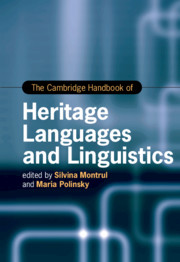Book contents
- The Cambridge Handbook of Heritage Languages and Linguistics
- Cambridge Handbooks In Language And Linguistics
- The Cambridge Handbook of Heritage Languages and Linguistics
- Copyright page
- Dedication
- Contents
- Figures and Tables
- Contributors
- Acknowledgments
- Introduction
- Part I Heritage Languages around the World
- Part II Research Approaches to Heritage Languages
- Part III Grammatical Aspects of Heritage Languages
- 23 Phonetics and Phonology of Heritage Languages
- 24 Morphology of Heritage Languages
- 25 Syntax of Heritage Languages
- 26 Semantics of Heritage Languages
- 27 Discourse and Information Structure in Heritage Languages
- 28 Pragmatics in Heritage Languages
- Part IV Heritage Language Education
- Index
- References
27 - Discourse and Information Structure in Heritage Languages
from Part III - Grammatical Aspects of Heritage Languages
Published online by Cambridge University Press: 04 November 2021
- The Cambridge Handbook of Heritage Languages and Linguistics
- Cambridge Handbooks In Language And Linguistics
- The Cambridge Handbook of Heritage Languages and Linguistics
- Copyright page
- Dedication
- Contents
- Figures and Tables
- Contributors
- Acknowledgments
- Introduction
- Part I Heritage Languages around the World
- Part II Research Approaches to Heritage Languages
- Part III Grammatical Aspects of Heritage Languages
- 23 Phonetics and Phonology of Heritage Languages
- 24 Morphology of Heritage Languages
- 25 Syntax of Heritage Languages
- 26 Semantics of Heritage Languages
- 27 Discourse and Information Structure in Heritage Languages
- 28 Pragmatics in Heritage Languages
- Part IV Heritage Language Education
- Index
- References
Summary
This chapter presents an overview of the state of the art in the study of the linguistic realization of information structure and discourse structure in heritage languages (HLs). It surveys the key issues pertaining to the encoding and interpretation of topic and focus, categories related to the distinction between given and new information in discourse, and their role in the development of mechanisms for the construal and maintenance of pronominal anaphoric dependencies in HL systems. Given the broad cross-linguistic variation in the expression of information structure and a vast range of phenomena that fall under its scope, the chapter provides overviews of the particular morphological, syntactic, prosodic, and lexical means employed for the encoding of information-structural relations in typologically different HLs, followed by discussion that identifies some common principles emerging from the surveyed studies and relates them to current issues in heritage language acquisition research. Finally, some directions for future work in this area are offered.
- Type
- Chapter
- Information
- The Cambridge Handbook of Heritage Languages and Linguistics , pp. 691 - 727Publisher: Cambridge University PressPrint publication year: 2021
References
- 3
- Cited by



